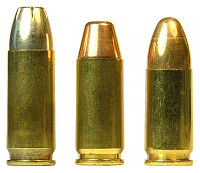9×23mm Winchester
| 9×23mm Winchester | ||||||||||||||||||||||||
|---|---|---|---|---|---|---|---|---|---|---|---|---|---|---|---|---|---|---|---|---|---|---|---|---|

9×23mm Winchester (left) compared with 9×21mm (center) and 9×19mm Parabellum (right)
|
||||||||||||||||||||||||
| Type | Pistol | |||||||||||||||||||||||
| Place of origin |
|
|||||||||||||||||||||||
| Production history | ||||||||||||||||||||||||
| Designer |
Winchester Ammunition (John Ricco) (Anthony Valdez) |
|||||||||||||||||||||||
| Designed | 1996 (1994) |
|||||||||||||||||||||||
| Specifications | ||||||||||||||||||||||||
| Parent case | .38 super | |||||||||||||||||||||||
| Case type | Rimless, straight | |||||||||||||||||||||||
| Bullet diameter | 9.04 mm (0.356 in) | |||||||||||||||||||||||
| Neck diameter | 9.68 mm (0.381 in) | |||||||||||||||||||||||
| Base diameter | 9.93 mm (0.391 in) | |||||||||||||||||||||||
| Rim diameter | 10.01 mm (0.394 in) | |||||||||||||||||||||||
| Case length | 22.86 mm (0.900 in) | |||||||||||||||||||||||
| Overall length | 33.02 mm (1.300 in) | |||||||||||||||||||||||
| Primer type | small pistol *Some people use small rifle primers |
|||||||||||||||||||||||
| Maximum pressure | 55,000 psi | |||||||||||||||||||||||
| Ballistic performance | ||||||||||||||||||||||||
|
||||||||||||||||||||||||
|
Test barrel length: Varied Source(s): Winchester Ammunition; C.I.P.SAAMI |
||||||||||||||||||||||||
The 9×23mm Winchester is a pistol cartridge developed as a joint venture by Winchester Ammunition and Colt's Manufacturing Company. The 9×23mm Winchester has a convoluted development history, but was commercially introduced by Winchester in 1996. Marketed primarily to competition shooters as a replacement for .38 Super for International Practical Shooting Confederation, United States Practical Shooting Association and International Defensive Pistol Association competition, the cartridge made a splash, but never really caught on.
The critical design feature of the 9×23mm Winchester is a much-strengthened case that does away with the semi-rimmed case design of the .38 Super which sometimes caused feeding problems. The strengthened case allows the 9×23mm Winchester to operate under a higher internal pressure, 55,000 psi (measured with a piezoelectric transducer), in comparison to the maximum pressure of 36,500 psi for the .38 Super (current SAAMI standards). It has a slightly tapered but nearly parallel case which means that it has greater magazine capacity for the same 9 mm bore diameter relative to the necked down cases of the .357 SIG, 9×25mm Super Auto G, or 9×25mm Dillon. To achieve enough propellant capacity for the power needed the 9×23mm Winchester is longer than the 9×19mm Parabellum or .357 SIG and so requires the extra magazine front to back length of a 1911 style magazine.
Patent 5,187,324 was filed by John Ricco of CP Bullets in 1992 for an "improved 9mm cartridge casing" that he called the 9×23mm Super. He had the prototype brass casings made by Winchester Ammunition. They then modified the design slightly and filed it under patent 5,507,232 in 1995. In comparison to the popular 9×19mm Parabellum, Winchester had lengthened the overall case by 4 mm and made it much stronger. They named it the 9×23mm Winchester. In comparison to the long established .38 Super Auto, also a 9×23mm, the new cartridge was rimless rather than semi rimmed.
...
Wikipedia
